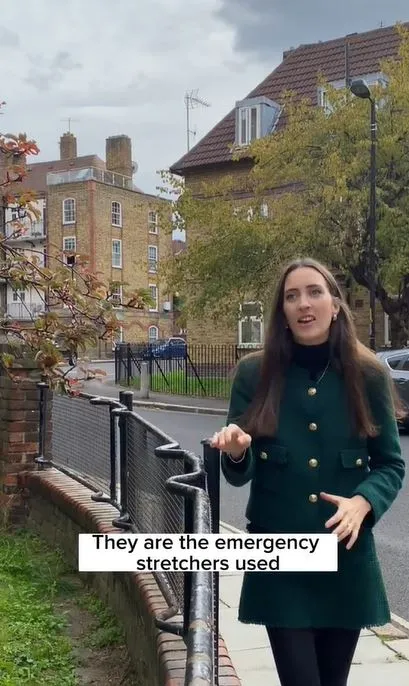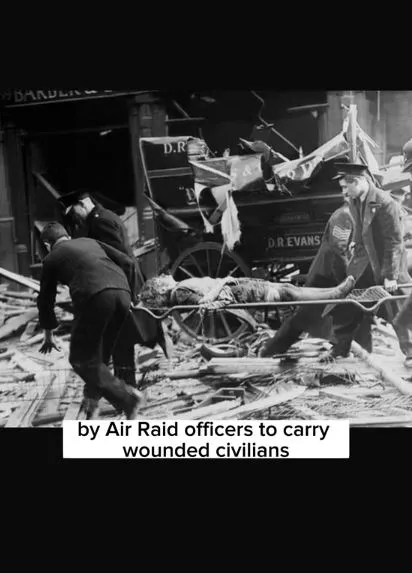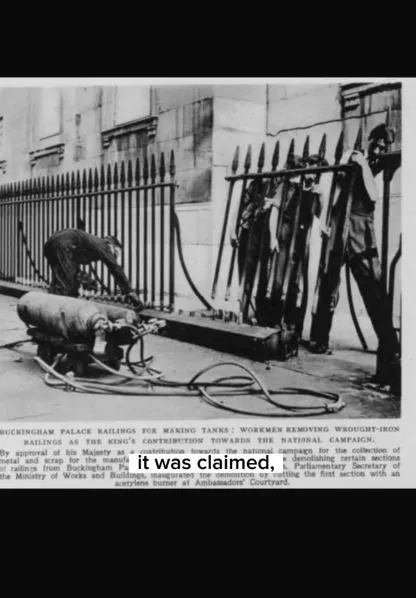As we go about our daily lives, navigating the bustling streets of cities like London, we often overlook the little details that make up the urban landscape. One such detail, the humble street railing, has long been a fixture of the cityscape, blending into the background as just another functional, forgettable element of the built environment.
But, as it turns out, these seemingly ordinary railings hold a fascinating and little-known secret. A recent viral TikTok video, shared by historian Alice Loxton, has lifted the veil on the hidden history of these kinked street railings, revealing a story of heroism, innovation, and the ingenuity of those who fought to protect their communities during the darkest days of World War II.

People are astonished upon uncovering the hidden history of kinked street railings. Image Credits: @history_alice.Tiktok
Through Loxton’s insightful commentary, we’ve come to understand that these curious kinks in the railings were not mere design flourishes, but rather a practical solution to a pressing wartime need. As the Blitz raged on, the railings were repurposed as emergency stretchers, crucial tools in the efforts to transport wounded civilians to safety.
This remarkable revelation has captivated the public imagination, sparking a renewed appreciation for the unsung heroes and untold stories that so often lie hidden in plain sight. And as we delve deeper into the history of these kinked railings, we uncover a tale of resilience, innovation, and the power of ordinary people to make a profound difference in extraordinary times.
It’s easy to overlook the humble street railing, a ubiquitous feature of the urban landscape that we so often take for granted. But in the darkest days of World War II, these seemingly innocuous fixtures played a vital role in the fight to protect the people of London.
As the Blitz raged on, with devastating air raids raining down on the city, the need for efficient, reliable methods of transporting the wounded became increasingly urgent. Enter the kinked street railing, a design feature that would prove to be ingenious in its simplicity and functionality.

Historian Alice Loxton explained the hidden purpose of kinked street railings. Image Credits: @history_alice.Tiktok
According to historian Alice Loxton, these kinks were intentionally engineered to serve as emergency stretchers, allowing Air Raid Precaution (ARP) officers to quickly and easily transport injured civilians to safety. The bend in the railing provided the perfect shape to cradle a person, while the rigid metal construction ensured the stretcher could withstand the demands of its grim task.
But the story of the kinked railings doesn’t end there. As the war effort intensified, many of the original railings were removed to contribute their metal to the war effort, leaving streets dotted with only short stumps. When the time came to rebuild and tidy up the city, these old ARP stretchers were repurposed as the new street railings, seamlessly blending the past and present in a testament to the resourcefulness and resilience of the British people.
In the midst of the chaos and destruction of the Blitz, the designers and engineers responsible for these kinked railings were tasked with a critical challenge: how to create a functional, cost-effective, and easily maintained solution to the pressing need for emergency stretchers.

The railings had a vital role during World War II, contrary to their appearance. Image Credits: @history_alice.Tiktok
The kinked design they settled upon was a stroke of genius, showcasing the power of smart, efficient design to make a tangible difference in the face of adversity. By utilizing a single material – the metal railings themselves – these stretchers were not only easy to produce but also simple to clean, a vital consideration in the event of a gas attack.
The bend in the railing, meanwhile, served a dual purpose. Not only did it provide the perfect ergonomic shape to support an injured person, but it also elevated the stretcher off the ground, making it easier for ARP officers to carry and maneuver through the chaos of the Blitz.
It’s a testament to the ingenuity and foresight of those who created these kinked railings that their design has endured, not just as a functional element of the cityscape, but as a physical embodiment of the resilience and resourcefulness of the British people during their darkest hour.

They were used as emergency stretchers by Air Raid officers to carry wounded civilians. Image Credits: @history_alice.Tiktok
As the viral TikTok video shared by historian Alice Loxton has shown, the kinked street railings of London have a story that extends far beyond their utilitarian function. These unassuming fixtures have become a tangible link to the past, a physical reminder of the sacrifices and innovations that helped the city weather the storm of World War II.
But the legacy of the kinked railings extends even further, serving as a poignant symbol of the power of design to make a meaningful difference in the world. In an era when form so often follows function, these railings stand as a testament to the idea that small, thoughtful details can have a profound impact, especially in the face of crisis.

Made from a single material, they were cost-effective, easy to clean, and carried easily. Image Credits: @history_alice.Tiktok
Today, as we navigate the modern city, the kinked railings continue to dot the streets, their subtle curves and bends blending seamlessly into the urban landscape. Yet, for those who know their history, these railings are a constant reminder of the ingenuity, resilience, and heroism that defined the British people during their darkest hour.
In a world that is all too often consumed by the fast-paced, the flashy, and the superficial, the kinked railings of London serve as a powerful antidote – a humble, unassuming element that nonetheless holds within it a story of courage, innovation, and the enduring human spirit. And as we continue to uncover and share these hidden histories, we inspire a newfound appreciation for the everyday objects that so often shape the world around us.
The story of London’s kinked street railings is a powerful reminder that the most meaningful and impactful innovations often come from the most unexpected places. In a world that so often values novelty and flashiness over substance and significance, these humble fixtures stand as a testament to the power of design to make a real difference in people’s lives.

Many railings were removed for the war effort, and the remaining stumps were reused in the city’s rebuilding. Image Credits: @history_alice.Tiktok
As we’ve learned, the kinks in these railings were not merely a design flourish, but a practical solution to a pressing wartime need. During the Blitz, these railings were repurposed as emergency stretchers, playing a vital role in the effort to transport wounded civilians to safety. And when the war ended and the city began to rebuild, these old ARP stretchers were integrated into the new streetscape, blending past and present in a seamless and meaningful way.
This story speaks to the enduring power of innovation, resourcefulness, and the human spirit. In the face of unimaginable adversity, the people of London found a way to turn the ordinary into the extraordinary, transforming a simple street railing into a lifesaving tool. And in doing so, they left behind a legacy that continues to inspire and captivate us to this day.
As we move forward, it’s crucial that we take the lessons of the kinked railings to heart. We must strive to see the hidden potential in the everyday, to embrace the power of design to make a tangible difference, and to honor the sacrifices and innovations of those who have come before us. Only then can we truly build a better, more resilient future – one that is rooted in the lessons of the past, but focused on the boundless possibilities of the present and the years to come.


